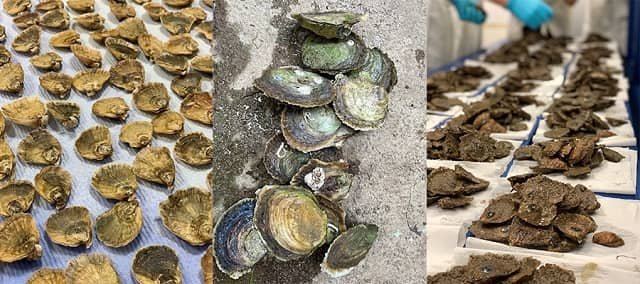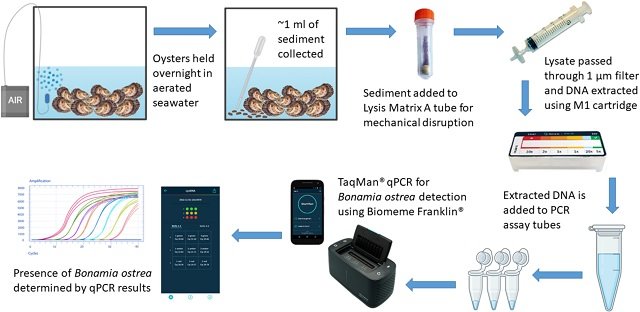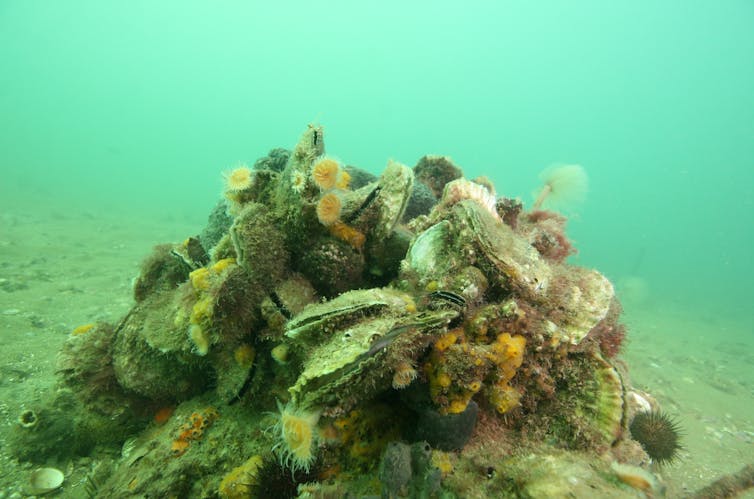by The University of Edinburgh
Genetic code findings could help produce larger, healthier shellfish.

Insights into the DNA of European flat oysters from a series of studies could inform selective breeding approaches for the scarce shellfish, to improve food security and sustainability.
Scientists from the Roslin Institute developed extensive genetic resources detailing the DNA of oysters and used them to help address the challenges this species faces in terms of conservation, restoration and aquaculture.
Two areas of the oyster genome are significantly associated with faster growth, the researchers have found.
The incorporation of genomic information into breeding schemes could be a cost-effective way of enhancing growth traits such as weight and shell size in oysters, scientists concluded.
A separate study, led by scientists from the University of Santiago de Compostela and involving Roslin experts, discovered that variations in a region of oyster DNA may be associated with tolerance to a deadly parasite.
Reference genome
To help understand all the genetics information in their studies, the researchers decoded the complete DNA code of the European flat oyster.
Two high-quality reference genomes were separately built to the chromosome level by the Roslin team and scientists from Sorbonne University in France.
Stay Always Informed
Join our communities to instantly receive the most important news, reports, and analysis from the aquaculture industry.
Both genomes have been published in Evolutionary Applications and are already being widely used by oyster researchers in Europe.
Growth traits
Scientists analysed the genome of the European flat oyster to look for variations and assess whether growth traits are under genetic control and could therefore be improved through selective breeding.
This research, published in Frontiers in Genetics, concluded that it is feasible to genetically improve growth traits in oysters.
Parasite tolerance
In a separate study, scientists compared the genome of oysters that had not been exposed to the deadly parasite Bonamia ostreae with that of long-term affected populations.
The team looked into areas of the oyster genome previously linked to resilience to the parasite and found an area associated with resilience to the parasite.
The study was published in Evolutionary Applications.
Oysters were once a plentiful source of food and a mainstay of the Scottish people, but have long been in decline. Our studies, in collaboration with UK and European academics, industry, environmental charities, and government scientists, used genomics and genetic tools to help inform breeding strategies of the native European flat oyster.
“Our results could contribute to sustainable food production, as oysters have among the lowest environmental impact of any animal protein production,” said Dr Tim Bean, Oyster research expert, Roslin Institute.
“High quality reference genome assemblies are of immense value when applying genetic tools in aquaculture and conservation. Our genome assembly enhances the resources available for flat oyster research, supports ongoing conservation efforts and selective breeding programmes, and improves our understanding of bivalve genome evolution,” said Dr Manu Gundappa, Post-doctoral research fellow, Roslin Institute.
“Our study shows that breeding programmes for flat oyster aquaculture and restoration would benefit from the incorporation of genetic information to identify the best candidates for breeding, thereby fast-tracking genetic progress in key traits in a sustainable way,” said Dr Carolina Peñaloza, Post-doctoral research fellow, Roslin Institute.
Reference (open access)
Gundappa, M.K., Peñaloza, C., Regan, T., Boutet, I., Tanguy, A., Houston, R.D., Bean, T.P. and Macqueen, D.J. (2022), Chromosome level reference genome for European flat oyster (Ostrea edulis L.). Evol Appl. Accepted Author Manuscript. https://doi.org/10.1111/eva.13460
Peñaloza Carolina, Barria Agustin, Papadopoulou Athina, Hooper Chantelle, Preston Joanne, Green Matthew, Helmer Luke, Kean-Hammerson Jacob, Nascimento-Schulze Jennifer C., Minardi Diana, Gundappa Manu Kumar, Macqueen Daniel J., Hamilton John, Houston Ross D., Bean Tim P. Genome-Wide Association and Genomic Prediction of Growth Traits in the European Flat Oyster (Ostrea edulis). Front. Genet., 02 August 2022, Sec. Livestock Genomics, https://doi.org/10.3389/fgene.2022.926638
Bean, T. P., Tanguy, A., Peñaloza, C., Gundappa, M. K., Boutet, I., Houston, R. D., Macqueen, D. J., & Boudry, P. (2022). Two parallel chromosome-level reference genomes to support restoration and aquaculture of European flat oyster Ostrea edulis. Evolutionary Applications, 00, 1– 4. https://doi.org/10.1111/eva.13465
Sambade, I. M., Casanova, A., Blanco, A., Gundappa, M. K., Bean, T. P., Macqueen, D. J., Houston, R. D., Villalba, A., Vera, M., Kamermans, P., & Martínez, P. (2022). A single genomic region involving a putative chromosome rearrangement in flat oyster (Ostrea edulis) is associated with differential host resilience to the parasite Bonamia ostreae. Evolutionary Applications, 00, 1– 15. https://doi.org/10.1111/eva.13446
Editor at the digital magazine AquaHoy. He holds a degree in Aquaculture Biology from the National University of Santa (UNS) and a Master’s degree in Science and Innovation Management from the Polytechnic University of Valencia, with postgraduate diplomas in Business Innovation and Innovation Management. He possesses extensive experience in the aquaculture and fisheries sector, having led the Fisheries Innovation Unit of the National Program for Innovation in Fisheries and Aquaculture (PNIPA). He has served as a senior consultant in technology watch, an innovation project formulator and advisor, and a lecturer at UNS. He is a member of the Peruvian College of Biologists and was recognized by the World Aquaculture Society (WAS) in 2016 for his contribution to aquaculture.




